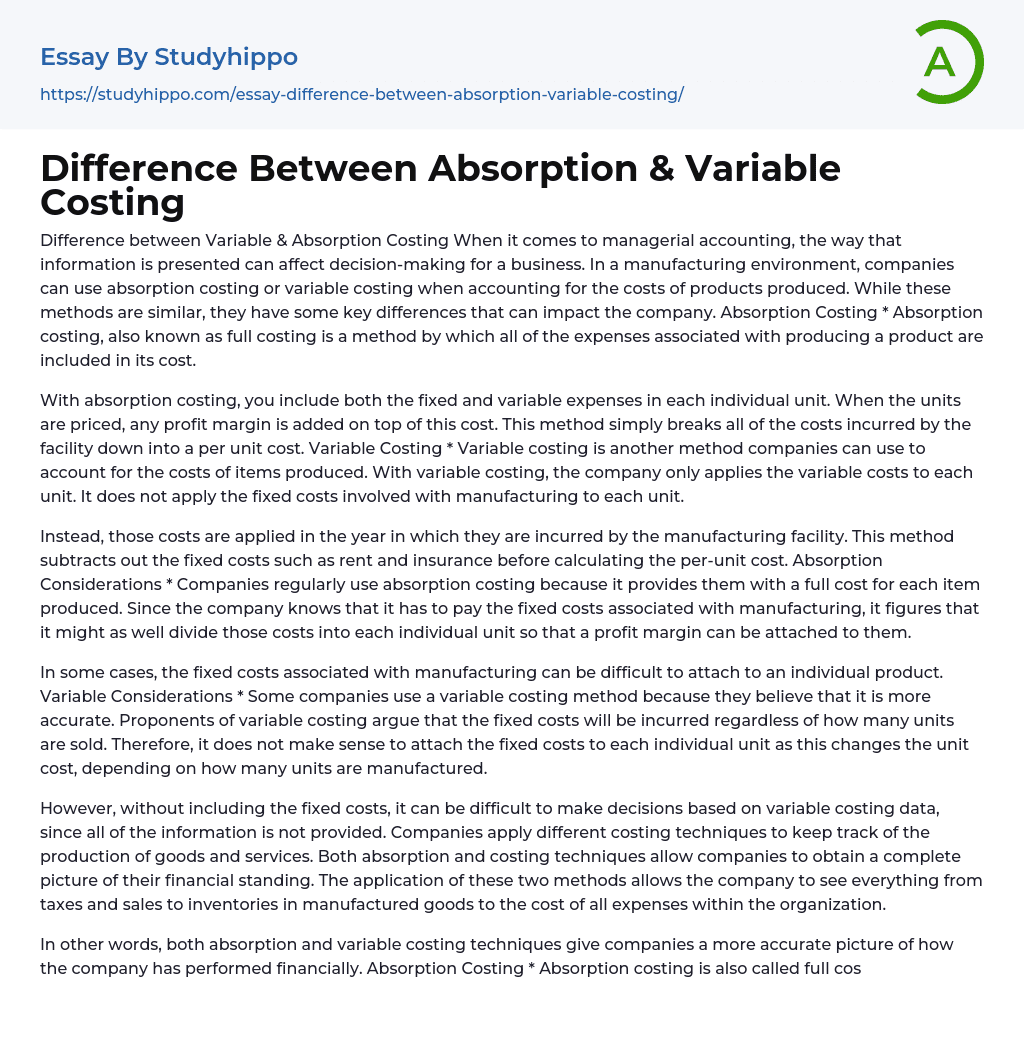

Difference Between Absorption & Variable Costing Essay Example
Managerial accounting plays a vital role in decision-making processes within businesses as the way information is displayed can greatly influence outcomes. Particularly in manufacturing settings, firms have the option to utilize either absorption costing or variable costing as their method of tracking production costs. Although these techniques share similarities, they also possess distinct differences which could potentially impact the business. For instance, absorption costing, often referred to as full costing, incorporates all expenses related to product creation into its cost calculation.
The method of absorption costing incorporates both fixed and variable costs for each unit, in addition to the profit margin. It distributes all overheads of the facility into a per-unit charge. Conversely, variable costing assigns only the varying expenses to each product and excludes any constant manufacturing costs.
xt-align: justify">
Instead, the manufacturing facility applies those costs in the year they are incurred. This approach deducts fixed costs like rent and insurance before calculating the per-unit cost. Companies commonly employ absorption costing as it gives a complete cost for each produced item. Knowing they have to cover fixed manufacturing costs, companies prefer to allocate those costs to individual units and add a profit margin.
Certain businesses favor the use of variable costing as they believe it provides a more precise calculation. Supporters of this method argue that fixed costs will be charged irrespective of how many units are sold. Therefore, distributing fixed costs to every unit produced seems unreasonable because it would change the cost per unit depending on the production volume.
Not accounting for fixed costs can complicate decision-making processes using variable costing data, as it fails to offer
all the required details. Firms employ different costing strategies to oversee their goods and services production. Both absorption and costing methodologies allow businesses to gain an in-depth understanding of their financial situation. Utilization of these techniques aids the company in considering factors like taxes, sales, stockpile of produced items, and organization-wide expenditure.
Both absorption and variable costing techniques provide companies with a more precise view of their financial performance. Absorption Costing, also known as full costing or the full absorption method, involves allocating all manufacturing costs to the products produced. This means that the price of each piece of finished inventory includes direct labor, direct materials, and variable and fixed manufacturing overhead. These costs encompass wages for workers, materials used in production, and overhead costs.
Absorption costing is utilized for external financial reporting and income tax reporting. It offers advantages and disadvantages. The advantage is that it provides the company with a clear understanding of the total cost of products, including fixed manufacturing and overhead. Accountants employ this method when preparing financial statements as it accurately recognizes the significance of fixed costs in production. Furthermore, absorption costing results in less fluctuation in net profits and distortion of stock evaluation.
The primary disadvantage of absorption costing is its lack of efficiency in management decision making, planning and control. Alternatively, variable costing correlates directly with the volume of production implying that as production levels rise or fall, so do variable costs. Examples of these fluctuating costs encompass direct material expenses, labor outlays directly linked to production and variable manufacturing overheads. These costs are inherent within the manufacturing process and invariably vary in line with
shifts in production volumes.
The variable cost figure does not include fixed costs like rent and management salaries. The company's costing method depends on multiple factors and both systems offer a better understanding of the production process and improve financial reporting to investors and financial institutions.
- Audit essays
- Budgeting essays
- Cost Accounting essays
- Accounting essays
- Andrew Carnegie essays
- Automation essays
- Business Cycle essays
- Business Intelligence essays
- Business Model essays
- Business Operations essays
- Business Software essays
- Cooperation essays
- Cooperative essays
- Corporate Social Responsibility essays
- Corporation essays
- Customer Relationship Management essays
- Family Business essays
- Franchising essays
- Harvard Business School essays
- Harvard university essays
- Human Resource Management essays
- Infrastructure essays
- Inventory essays
- Logistics essays
- Management essays
- Manufacturing essays
- Market essays
- Marketing essays
- Multinational Corporation essays
- News Media essays
- Online Shopping essays
- Quality Assurance essays
- Richard Branson essays
- Sales essays
- Selling essays
- Shopping Mall essays
- Small Business essays
- Starting a Business essays
- Stock essays
- Strategy essays
- Structure essays
- Trade Union essays
- Waste essays
- Bargaining essays
- Chief Executive Officer essays
- Convenience Store essays
- Entity essays
- Firm essays
- Pest analysis essays
- Training And Development essays



